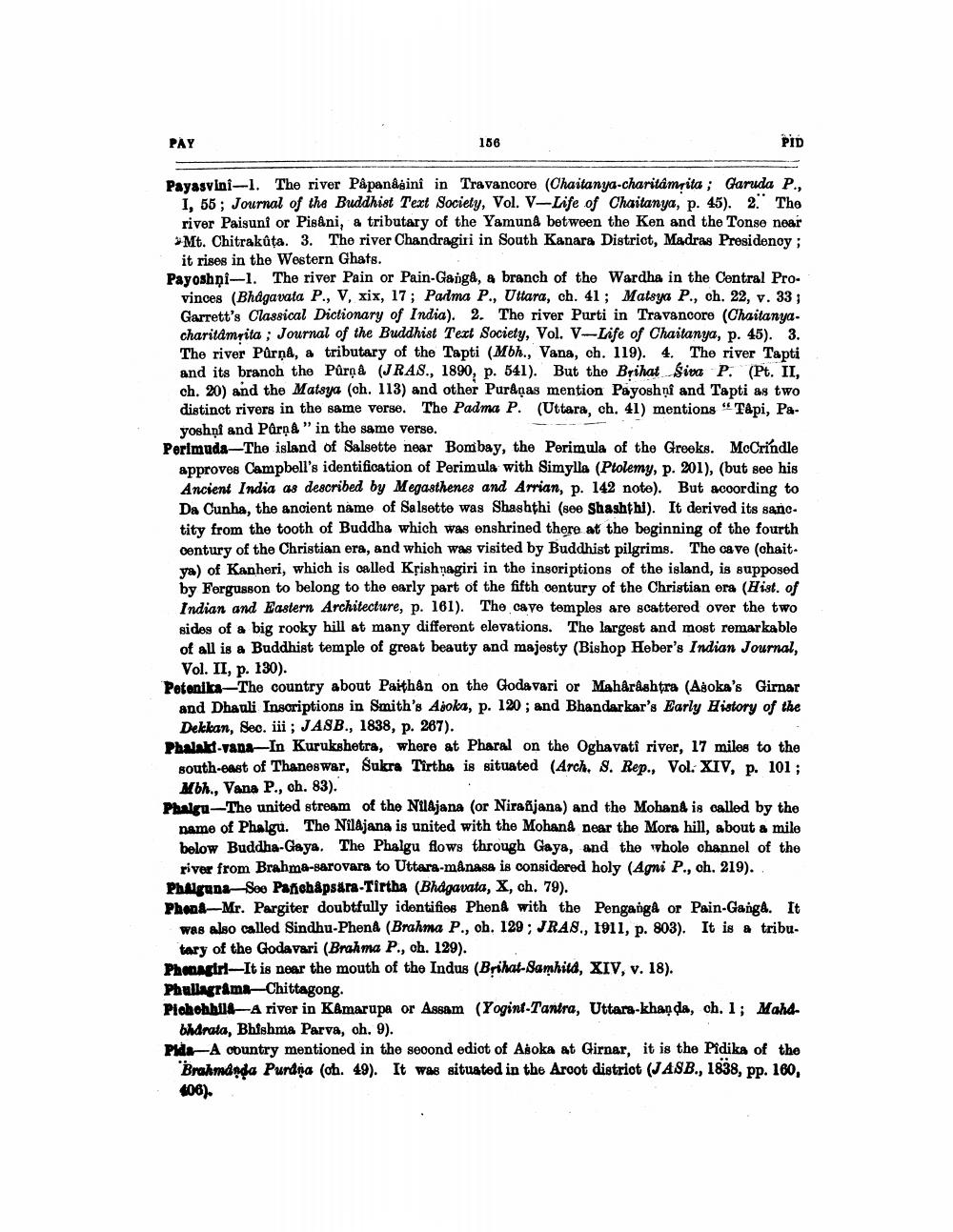________________
PAY
156
PID
Payasvini-1. The river Pâpanagini in Travancore (Chaitanya-charitâmrita ; Garuda P.,
1, 55; Journal of the Buddhist Text Society, Vol. V-Life of Chaitanya, p. 45). 2. The river Paisuni or Pisani, a tributary of the Yamund between the Ken and the Tonse near Mt. Chitrakûţa. 3. The river Chandragiri in South Kanara District, Madras Presidenoy ;
it rises in the Western Ghats. Payoshni-1. The river Pain or Pain-Ganga, a branch of the Wardha in the Central Pro
vinces (Bhagavata P., V, xix, 17; Padma P., Uttara, ch. 41; Matsya P., ch. 22, v. 33; Garrett's Classical Dictionary of India). 2. The river Purti in Travancore (Chaitanya. charitamrita ; Journal of the Buddhist Text Society, Vol. V-Life of Chaitanya, p. 45). 3. The river Pārņâ, a tributary of the Tapti (Mbh., Vana, ch. 119). 4. The river Tapti and its branch the Purga (JRAS., 1890, p. 541). But the Brihat Siva P. (Pt. II, ch. 20) and the Matsya (ch. 113) and other Purdgas mention Payoshni and Tapti as two distinct rivers in the same verse. The Padma P. (Uttara, ch. 41) mentions "Tapi, Pa
yoshni and Pärņa " in the same verse. Perimuda-The island of Salsette near Bombay, the Perimula of the Greeks. McCrindle
approves Campbell's identification of Perimula with Simylla (Ptolemy, p. 201), (but see his Ancient India as described by Megasthenes and Arrian, p. 142 note). But acoording to Da Cunha, the ancient name of Salsette was Shashthi (see Shashthi). It derived its sanc. tity from the tooth of Buddha which was enshrined there at the beginning of the fourth century of the Christian era, and which was visited by Buddhist pilgrims. The cave (chait. ya) of Kanheri, which is oalled Krishnagiri in the insoriptions of the island, is supposed by Fergusson to belong to the early part of the fifth century of the Christian era (Hist. of Indian and Eastern Architecture, p. 161). The cave temples are scattered over the two sides of a big rooky hill at many different elevations. The largest and most remarkable of all is a Buddhist temple of great beauty and majesty (Bishop Heber's Indian Journal,
Vol. II, p. 130). Petonik-The country about Paithan on the Godavari or Maharashtra (Asoka's Girnar and Dhanli Inscriptions in Smith's Ajoka, p. 120 ; and Bhandarkar's Early History of the
Dekkan, Sec. iii ; JASB., 1838, p. 287). Phalakt vana-In Kurukshetra, where at Pharal on the Oghavati river, 17 miles to the
south-east of Thaneswar, Sukra Tirtha is situated (Arch. 8. Rep., Vol. XIV. p. 101:
Mbh., Vana P., oh. 83). Phalgu-The united stream of the Nilájana (or Nirasjana) and the Mohand is called by the
name of Phalgu. The Nilajana is united with the Mohana near the Mora hill, about a mile below Buddha-Gaya. The Phalgu flows through Gaya, and the whole channel of the
river from Brahma-sarovara to Uttara-månasa is considered holy (Agni P., ch. 219). Ph. Nguna-Soo Panchåpsåra-Tirtha (Bhdgavata, X, ch. 79). Phon-Mr. Pargiter doubtfully identifies Phend with the Penganga or Pain-Gang. It
WAA also called Sindhu-Phena (Brahma P., oh. 129; JRA8., 1911. p. 803). It is a tribu
tary of the Godavari (Brahma P., oh. 129). Phonagiri-It is near the mouth of the Indus (Brihat-Samhita, XIV, v. 18). Phallagrima-Chittagong. Plohohbill-A river in Kamarupa or Assam (Yogini Tantra, Uttara-khanda, ch. 1; Mahd
bharata, Bhishma Parva, oh. 9). P -A ovuntry mentioned in the second ediot of Asoka at Girnar, it is the Pidika of the
Brahmanda Pundna (ch. 49). It was situated in the Aroot district (JASB., 1838, pp. 160, 406).




